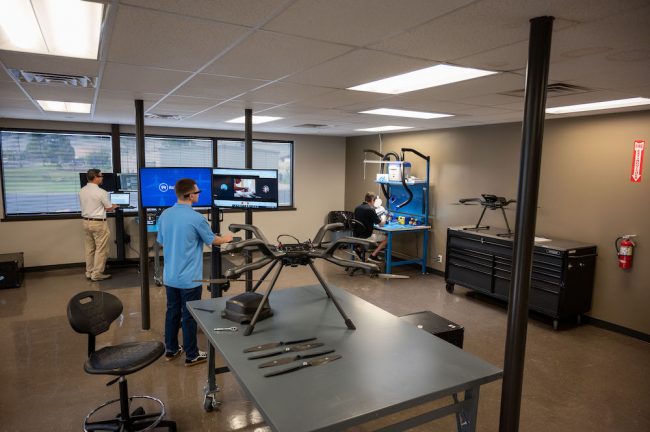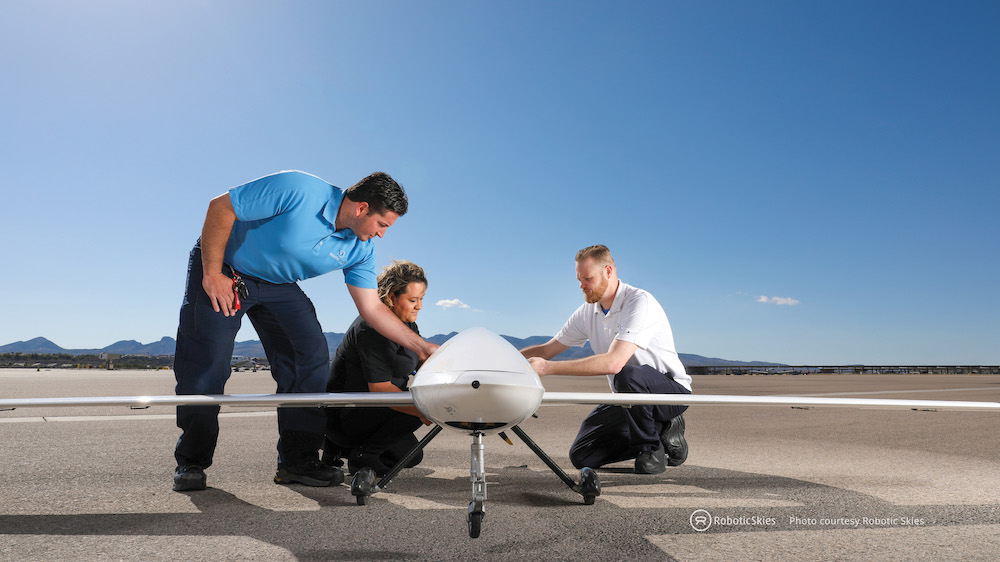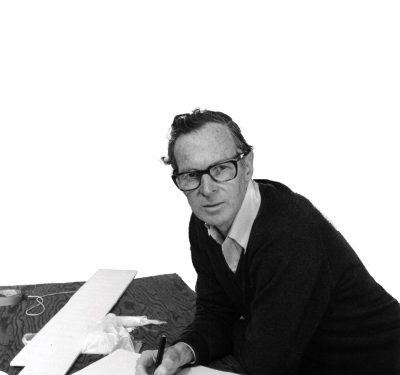“It’s very unsexy, just the way we like it, actually,” joked Brad Hayden, president and CEO of Robotic Skies. Rather than extolling the many things drones can do in the air, Hayden was explaining how his company works to keep them aloft.

Network technicians at work.
“Robotic Skies is a maintenance network comprised of Part 145 repair stations,” Hayden said, referencing the FAA certification governing maintenance standards. That credential turns out to be an important building block for the company’s network being able to include 230 on-site maintenance, repair and inspection service stations across more than 50 countries.
“We focus on high-end commercial unmanned aircraft systems,” Hayden said about his eight-year-old company. “We have 25 OEMs and various stages of R&Ds signed up for our services.”
Robotic Skies’ premise, Hayden continued, “is “to remove the maintenance burden from unmanned aircraft, manufacturers and operators, and manage the entire maintenance process for them. We work with them to develop their maintenance program, their technician training, their service levels, their maintenance intervals, and then we implement that in the field through our service centers.” The customer-ROI goal is to have quality on-sight servicing reduce the down time shipping might require and provide a footprint capable of scaling as business needs change.

Robotic Skies’ UAS service training.
Maintaining the Flight Path
Hayden himself grew up working on airplanes in a family business, but Robotic Skies has always involved UAS. “I knew drones were going to revolutionize aerospace, and so I knew they were going to need maintenance, and ultimately they’re going to need certified maintenance.”
The network’s home is a new, 7,600-square-foot facility in Salt Lake City. “We have a depot facility, what we call our ‘customer enablement facility,’ Hayden said. “I’ve got technicians there who work with the OEMs to develop the maintenance programs. We do the initial repairs, we become experts in the systems, and then we can run the repairs through our service centers.”
Growth comes from leveraging that model qualitatively and quantitatively.
“Our repair stations really have the same standards and capabilities of their [manned] aircraft, electronics technicians, and airframe and powerplant mechanics. We use these Part 145 repair stations because it’s hard to get that certification from the FAA, and then you have to maintain it. Meaning they get inspected at least once a year by their local FAA office; sometimes they bring in other FAA offices. So we know how they do business, how they accept jobs, how they process the repair and then how they return that aircraft to operation. We layer our processes on top of that. And so we start with this great foundation for a quality management system that we can then build upon.
“What’s important to remember is we’ve got five people but 1,000 technicians. They basically sign exclusive agreements with us. It’s more of a network business. We make our money when they make their money. So it’s not like they have to sign up and pay us a huge fee.”
Industry-Wide Obstacles
Hayden identified some issues in UAS maintenance. “Non-standardization of parts is tough. The supply chain is very immature at this point, and that makes it difficult for manufacturers. And it makes it difficult for us, because we have to wait on parts.
“There are too many options out there, if you will. You’ve got a lot of, let’s say, less expensive parts that don’t have the pedigree, or the supporting data on performance, which makes it really, really tough.
“For the industry at large, it’s definitely around the regulations. Everybody’s trying to figure out how these aircraft are going to be certified, if the certification is required and how they’re going to be integrated. It’s all about integration.”
Hayden serves on the FAA’s Drone Advisory Board. “The key with any aerospace endeavor, and this is aerospace, is you have to be involved in the regulatory process if you can help guide regulations as much as possible. Standards are becoming increasingly important. I work on ASTM committees and industry associations. All these organizations play a part in really holding this industry together and guiding it in the direction of enabling operations.”
Hayden’s sweet spot? “I would speed up the process without sacrificing safety. I think it’s a matter of figuring out how to get more budget, because the FAA is strapped for cash, like every other government organization. I think that if they had more budget, they’d be able to do everything that industry needs.”
He closed by reiterating his desire for standardization. “Right now, we really don’t have a good harmonization of standards around the world. In most countries, when you get on an aircraft to fly somewhere, that aircraft is maintained and operated very similarly. We don’t have that [UAS] harmonization yet around the world. Right now, it’s a full-time job keeping track of how all the different regulatory authorities are approaching unmanned.”
Photos courtesy of Robotic Skies.






